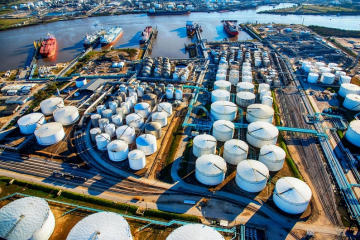During these unprecedented times, railroads and oil producers are considering railcars as alternative storage facilities, but there are regulatory implications.
During these unprecedented times, railroads and oil producers are considering railcars as alternative storage facilities, but what are the regulatory implications?
As oil production continues during the COVID-19 crises, companies are finding that the reduction in petroleum consumption by the public and commercial facilities may result in a lack of storage capacity for crude oil and other products. To solve this problem, some producers are considering turning to the rail companies that normally transport these products to potentially become storage facilities, using many of the oil tank cars that have been staged empty during previous lulls in the oil market. While this may be a cost-effective short-term solution, there are several regulatory implications that should be considered during the planning process.
Spill Prevention Control and Countermeasure Plans
Any facility that stores more than 1,320 gallons of oil must develop and maintain a spill prevention, control and countermeasure (SPCC) plan. Since many railyards already have an SPCC plan in place, the additional storage of railcars containing crude or other oils may not present much of a regulatory hurdle. Their existing plan can be amended to cover the storage of the railcars, and the supplement can be removed when the storage needs are over. Since the areas where the cars are stored is unlikely to have been designed with engineered controls, alternative secondary containment, such as active monitoring, will be needed.
The US Environmental Protection Agency (EPA) has expressed greater concern about creating “new” facilities, for example, storing oils at a yard that does not currently have an SPCC plan. Please keep in mind that an SPCC plan must be developed prior to the storage of oils, and no oils should be stored without an SPCC plan’s being in place. While the March 26th memorandum from Susan Bodine, Assistant Administrator for EPA's Office of Enforcement and Compliance Assurance (OECA), may allow the EPA to extend the time-period for SPCC plan development during this time of crisis, the agency has not yet determined if this regulatory requirement will be waived or not. Antea Group will continue to monitor this development.
Facility Response Plans and Risk Management Plans
Keep in mind that the quantity of materials stored and the nature of those materials could trigger the need for either a Facility Response Plan (FRP) or a Risk Management Plan (RMP).
If the facility will be storing more than 1 million gallons of oil, an FRP will be needed. For facilities that already have an FRP, their existing plan can be supplemented to address the new storage capacity. For facilities that do not currently have an FRP, but do have an SPCC plan, the EPA may allow 40 CFR 112.20(a)(2)(iv) to be invoked thus providing the facility with up to six months to prepare an FRP in a time of crises. However, if the facility currently has neither an SPCC plan nor an FRP and will start to store over 1 million gallons as a “new” facility, the agency is likely to require the plan to be developed prior to any storage.
Depending on the nature of the petroleum product, an RMP may be needed as well. Products like LPG are not generally considered oils that require an SPCC plan since they do not spread in the environment like vegetable or petroleum oils, but due to their flammability, they will require RMPs. Please keep in mind the additional security requirements and planning that an RMP may trigger at your facility.
Who is Responsible for the Planning?
The party responsible for the planning will depend on the arrangements reached between the railyard and the owner of the material. Generally, after four or five days the EPA is likely to consider any stored material to no longer be “in transit” for the purposes of an RMP or other plan. This can vary from region to region. While the Federal Railroad Administration (FRA) is currently considering special permitting to allow materials to be considered “in transit” for longer periods of time, the EPA has not determined whether they would accept that exception even if the FRA allows it. Antea Group will continue to monitor this situation as well.
If the railyard retains control of the cars that are no longer “in transit” by retaining control of the tracks they are stored on, then the rail company will be responsible for plan development. In some cases, this could be an advantage as the yard may already have an SPCC plan and storage can thus begin immediately with the development of an addendum. The downside is the liability for any leaks and spills. If the rail company leases the control of the storage area they also turn over the planning requirement to the product owner. While this may transfer the environmental liability away from the railroad, this also makes that portion of the yard a new “facility” and oil storage should not begin until an SPCC plan is in place. Before any storage begins, both companies should consider the most cost-effective way for them to manage the responsibilities and risks.
How Antea Group Can Help
Antea Group is helping our clients cope with this crisis by providing FRPs, RMPs, and SPCC plans when needed. We have a long history of experience developing these types of plans for the railroad and oil industry and would be happy to help!
We can also provide active monitoring in lieu of secondary containment to help meet the requirements of the SPCC plans. Our Incident Management program helps our clients prevent spills from rail storage facilities and respond to them when they occur, protecting both yard staff and the public with air monitoring and product containment.
Antea Group will stay in touch with the EPA and the FRA to monitor these developments during these rapidly changing times we find ourselves in. If at any time you may have questions, please feel free to reach out and ask.
FOR ALL OF THESE SERVICES, ANTEA GROUP IS READY TO HELP. CONTACT US.
Want more news and insights like this?
Sign up for our monthly e-newsletter, The New Leaf. Our goal is to keep you updated, educated and even a bit entertained as it relates to all things EHS and sustainability.
Get e-NewsletterHave any questions?
Contact us to discuss your environment, health, safety and sustainability needs today.





